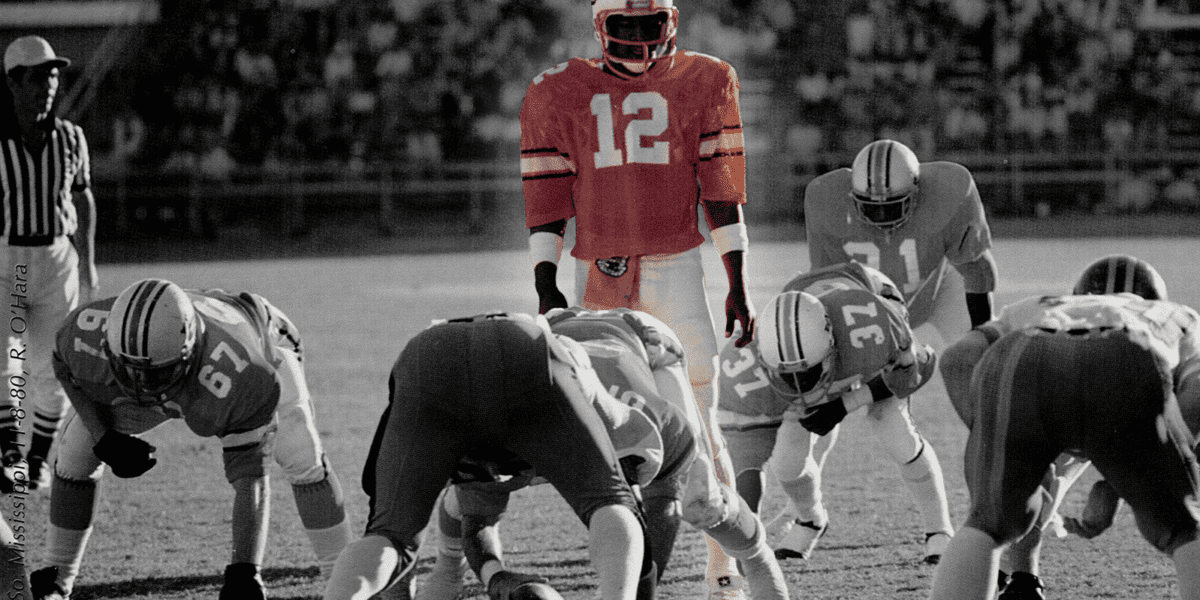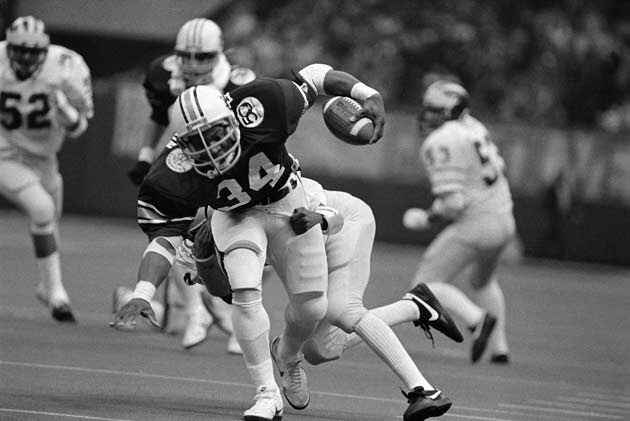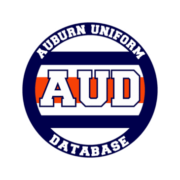Auburn Through the Years – Football: 1980
The Auburn Uniform Database is dedicated to documenting all Auburn athletic uniforms. This entry is part six of a series detailing the history of Auburn’s football uniforms. Be sure to check the previous entries, starting from the beginning or checking last week’s article.
1980
In what was Doug Barfield’s final season as coach, the Tigers continued to wear the weagle decals, orange facemasks, belts, and jerseys. No changes were made from the 1979 season, however.
Auburn would end the modern era with a 2-1-1 record while wearing the orange jerseys.
1981

Auburn’s tear-away jerseys rarely, if ever, featured the sleeve stripes and TV numbers. (image via 1982 Glomerata)
With a new coach comes a new uniform mentality. Pat Dye removed Barfield’s “weagle” decals and nameplates. The player numbers reappear on the helmets for the first time since 1967. The numbers were placed at the bottom of the stripes, making for a weird truncation look.
1981 was most likely the first time that Auburn wore a memorial of any kind of their uniforms, adding a thin black stripe – possibly electrical tape – to the helmets above the AU logos. The week prior to the Iron Bowl, two freshmen players – Alan Manley and Cary Condray – were killed in a car wreck.
1982
The era of tear-away jerseys is officially over, as the thinly-made rip-a-way tops were banned by the NCAA.
Back on the Plains, Auburn made a minor change, switching to blue belts rather than orange. Auburn also appeared in their first bowl game under Pat Dye.
The 1982 Citrus Bowl versus Doug Flutie’s Boston College Eagles marked the first time the Auburn Tigers wore bowl patches. The patches replaced the TV numbers on Auburn’s shoulders. Auburn also began adding player names to the back of the jerseys for bowl games.
1983
Auburn suffered another loss as fullback Greg Pratt collapsed after a workout. The Tigers would wear #36 decals on the back of the helmets throughout the season in his honor.
The Tigers excelled this season, earning their first SEC title under Dye and first bid to the Sugar Bowl since 197X. Auburn once again replaced the TV numbers with patches, but this time with only one representing the bowl game. The left shoulder featured the 50th Sugar Bowl patch as the right side was a special SEC Champions patch. Keeping with new tradition, the players wore their last name on their jerseys in the bowl game.
1984
The last remaining aesthetic artifact of the Doug Barfield era is removed, as Auburn changed the orange facemasks to blue.
Auburn earned a Liberty Bowl bid this season. The bowl patches appeared on the shoulders in lieu of the numbers and nameplates reappeared for the season finale.
1985
Bo Jackson’s Heisman Trophy-winning season didn’t see anything special in terms of the Tigers’ uniforms. As had been the case, Auburn wore nameplates in the bowl game with Cotton Bowl patches on the shoulders.
1986
The helmet numbers that once sat underneath the stripe are moved beside the stripe. The numbers are considerably smaller and the helmet stripe runs the full length of the helmet again.
Auburn made a Citrus Bowl appearance where, once again, the bowl patches were worn on the shoulders and nameplates made their only appearance of the year.
1987
White belts were added, replacing the previous blue style. Auburn made another appearance in the Sugar Bowl as did nameplates and the two different shoulder patches – Sugar Bowl patch on the left, 1987 SEC Champions on the right.
1988
The Tigers once again earned a bid to the Sugar Bowl. This time around, however, Auburn didn’t wear nameplates nor two different patches.
1989
1989 featured one of the smaller changes, as the Tigers added American flag decals to the helmets.
The Hall of Fame Bowl featured the largest bowl patches ever on an Auburn uniform, practically covering the entire shoulder. Nameplates once again make an appearance.
This season also marked the 50th anniversary of Jordan-Hare Stadium, resulting in possibly the first anniversary logo in Auburn football history.
Pat Dye brought a new era of football to Auburn and the Tigers saw many successful seasons. The 1980s might have been the best time for Auburn football, in fact.
Aesthetically, Auburn continued to tweak the uniforms over the seasons, but stayed true to the traditional look. As Dye cemented his coaching philosophy, so did Auburn settle on uniform designs. Gone were the orange aspects of the Barfield era, in were large shoulder patches for bowl games.
Next week, take a ride through the 1990s, as Auburn once again hits the highs and lows of on-field performance and uniform tastes. The ever divisive orange drop shadows make their appearance soon enough.
The Auburn Uniform Database is celebrating five years! Take time to check out the brand new website and consider purchasing an anniversary t-shirt. Do you enjoy uniforms and want to see more like this? Be sure to follow the Auburn Uniform Database, like the AUD Facebook page, Instagram page, and follow me on Twitter for even more uniform news. You can also purchase your favorite team’s merchandise through Fanatics, with a portion of your sale going to support this website.





Leave a Reply
Want to join the discussion?Feel free to contribute!